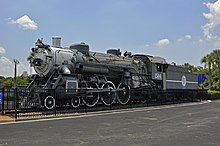
The Atlantic Coast Line Railroad was a United States Class I railroad formed in 1900, though predecessor railroads had used the ACL brand since 1871. In 1967, it merged with long-time rival Seaboard Air Line Railroad to form the Seaboard Coast Line Railroad. Much of the original ACL network has been part of CSX Transportation since 1986.
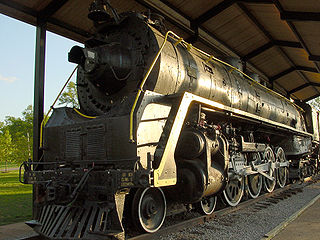
The Nashville, Chattanooga and St. Louis Railway was a railway company that operated in the U.S. states of Kentucky, Tennessee, Alabama, and Georgia. It began as the Nashville and Chattanooga Railroad, chartered in Nashville on December 11, 1845, built to 5 ft gauge and was the first railway to operate in the state of Tennessee. By the turn of the twentieth century, the NC&StL grew into one of the most important railway systems in the southern United States.

The Louisville and Nashville Railroad, commonly called the L&N, was a Class I railroad that operated freight and passenger services in the southeast United States.

The South Central Florida Express, Inc. is a common carrier shortline railroad in southern Florida run by U.S. Sugar Corporation. Its trains operate from Sebring to Fort Pierce via Clewiston around the southern perimeter of Lake Okeechobee, and serves customers at 26 locations. With 171 miles (275 km) of track, the SCXF is the largest private agricultural railroad in the U.S.

The Pennsylvania-Reading Seashore Lines was a railroad that operated in South Jersey in the 20th century. It was created in 1933 as a joint consolidation venture between two competing railroads in the region: the Pennsylvania Railroad and the Reading Company.

The Atlanta, Birmingham and Coast Railroad was organized in 1926 to replace the bankrupt Atlanta, Birmingham and Atlantic Railway. The AB&C was controlled by the Atlantic Coast Line Railroad, which owned a majority of the stock. In 1944 it reported 763 million net ton-miles of revenue freight and 33 million passenger-miles; at the end of that year it operated 639 miles of road and 836 miles of track.

Southern Railway 4501 is a preserved Ms class 2-8-2 "Mikado" type steam locomotive built in October 1911 by the Baldwin Locomotive Works in Philadelphia, Pennsylvania, as the first of its wheel arrangement type for the Southern Railway (SOU). In 1948, the locomotive was retired from the SOU in favor of dieselization and was sold to the shortline Kentucky and Tennessee Railway (K&T) in Stearns, Kentucky, to haul coal trains.
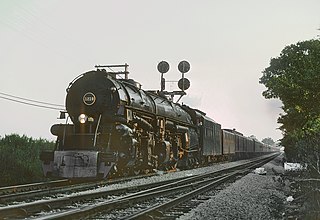
Norfolk and Western 1218 is a preserved four-cylinder simple articulated 2-6-6-4 steam locomotive, built in June 1943 by the Norfolk and Western's (N&W) Roanoke Shops in Roanoke, Virginia as part of the N&W's class "A" fleet of fast freight locomotives. It was retired from regular revenue service in July 1959, and was later restored by Norfolk Southern for excursion service for their steam program, pulling excursions throughout the eastern United States from 1987 to 1991. It is currently on display at the Virginia Museum of Transportation in Roanoke, Virginia.
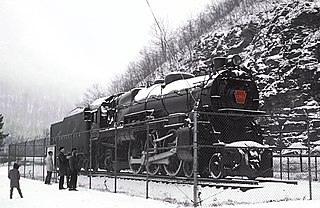
Pennsylvania Railroad 1361 is a 4-6-2 K4 "Pacific" type steam locomotive built in May 1918 by the Pennsylvania Railroad's (PRR) Juniata Shops in Altoona, Pennsylvania. It hauled mainline passenger trains in Pennsylvania and commuter trains in Central New Jersey on the PRR until its retirement from revenue service in 1956. Restored to operating condition for excursion service in 1987, No. 1361 and its only surviving sister locomotive, No. 3750, were designated as the official state steam locomotives by the Pennsylvania General Assembly. In 1988, it was sidelined due to mechanical problems and was currently owned by the Railroaders Memorial Museum (RMM) in Altoona, Pennsylvania, who were currently getting No. 1361 back to operation.

The USRA Light Pacific was a USRA standard class of steam locomotive designed under the control of the United States Railroad Administration, the nationalized railroad system in the United States during World War I. It was the standard light passenger locomotive of the USRA types, with a 4-6-2 wheel arrangement in the Whyte notation, or 2′C1′ in UIC classification.
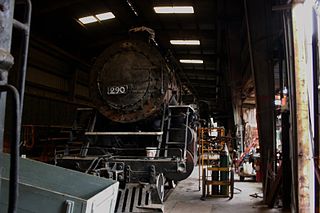
Atlanta and West Point 290 is a P-74 steam locomotive built in March 1926 by the Lima Locomotive Works (LLW) in Lima, Ohio for the Atlanta and West Point Railroad. It is a 4-6-2 heavy "Pacific" type steam locomotive, which was remarkably similar to the Southern Railway's Ps-4 class. With sister locomotive No. 190 built for the Western Railway of Alabama (WRA), No. 290 ferried the Southern Railway's Crescent passenger train from Atlanta, Georgia to Montgomery, Alabama until its retirement from revenue service in 1954.

Norfolk and Western 611, also known as the "Spirit of Roanoke" and the "Queen of Steam", is the only surviving example of Norfolk and Western's (N&W) class J 4-8-4 type "Northern" streamlined steam locomotives. Built in May 1950 at N&W's Roanoke Shops in Roanoke, Virginia, it was one of the last mainline passenger steam locomotives built in the United States and represents one of the pinnacles of American steam locomotive technology.

The Dixie Flyer was a premier named passenger train that operated from 1892 to 1965 via the "Dixie Route" from Chicago and St. Louis via Evansville, Nashville, and Atlanta to Florida. However, the train continued until 1969 as an Atlanta to Florida operation, run solely by the Atlantic Coast Line Railroad and its successor, the Seaboard Coast Line. The Flyer's route varied in early years, but by about 1920 was set as follows:

Maine Central 470 is a 4-6-2 "Pacific" type steam locomotive built by the American Locomotive Company (ALCO) in May 1924 for the Maine Central Railroad (MEC). Currently owned by the New England Steam Corporation, it is being restored to operating condition at Washington Junction in Hancock, Maine.
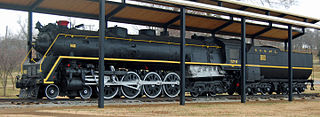
Nashville, Chattanooga and St. Louis 576 is a 4-8-4 "Dixie" (Northern) type steam locomotive built in August 1942 by the American Locomotive Company (ALCO) of Schenectady, New York, for the Nashville, Chattanooga and St. Louis Railway (NC&StL) as a member of the J3 class. Designed with some of the latest locomotive technological features of the time, the J3s were used to haul heavy freight and troop trains to aid the American war effort during World War II.
Chattanooga Union Station, more commonly known as the Union Depot in Chattanooga, constructed between 1857 and 1859, served as a train car shed in Chattanooga, Tennessee. Located at Broad and Ninth Streets, the station was one of two major railroad terminals in the city, the other being the Southern Railway's Terminal Station.

Baltimore and Ohio 4500 is a 2-8-2 "USRA Light Mikado" steam locomotive built by the Baldwin Locomotive Works in Philadelphia, Pennsylvania in July 1918 for the Baltimore and Ohio Railroad (B&O) as a member of the Q-3 class.
The Atlantic Coast Line R-1 was a class of 12 4-8-4 Northern type steam locomotives built by the Baldwin Locomotive Works in 1938 and operated by the Atlantic Coast Line Railroad until the early 1950s. They were immediately assigned to passenger service but eventually saw service pulling freight.

U.S. Sugar 148, formerly Florida East Coast 148, is a 4-6-2 steam locomotive built in April 1920 by the American Locomotive Company (ALCO) of Richmond, Virginia, originally for the Florida East Coast Railway (FEC). It hauled passenger and freight trains on the FEC's Overseas Railroad to Key West, Florida until the line was destroyed in 1935. The locomotive was sold in 1952 to U.S. Sugar Corporation (USSC) to haul sugarcane trains in Clewiston, Florida.

Savannah and Atlanta 750, formerly Florida East Coast 80, is a 4-6-2 “Light Pacific” steam locomotive built in January 1910 by the American Locomotive Company (ALCO) of Schenectady, New York, originally for the Florida East Coast Railway (FEC) as No. 80. Throughout the 1930s, FEC had sold of several of their locomotives, with No. 80 being sold in 1935 to the Savannah and Atlanta Railway, where it was renumbered to 750. The locomotive pulled commuter passenger trains and occasional mixed freight trains for the S&A, until the railroad dieselized in the early 1950s. In 1962, the locomotive was donated to the Atlanta Chapter of the National Railway Historical Society, who began using the locomotive to pull occasional excursion trains. No. 750 was subsequently leased to the Southern Railway for use to pull trains for their new steam excursion program, and the lease ended in 1984. From 1985 to 1989, the locomotive pulled excursion trains for the New Georgia Railroad around Atlanta, until it was retired, due to firebox issues. As of 2022, No. 750 remains on static display inside the Southeastern Railway Museum in Duluth, Georgia.


